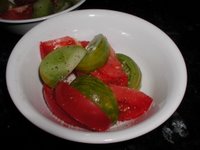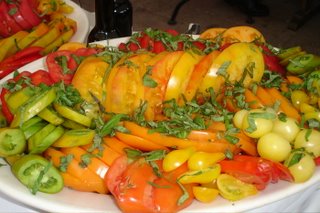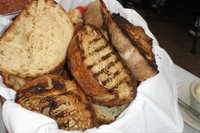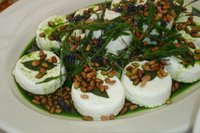Light Summer Pasta

So remember that chicken I roasted earlier in the week? Tonight I turned it into a really tasty summer pasta dish that's also pretty good for you. The recipe is loosely based on one from Cook's Illustrated Janary 2005 issue, but only loosely. For one thing, I cut the fat in the recipe by about 3/4, and didn't miss it a bit.
Be sure to use a wine that you like in this pasta - a huge amount of the flavor of the pasta sauce will come from it, so this isn't the place to use up the dregs of something someone left at your house. I used a 2005 Seigneurs de Bergerac Bergerac Sec. It's one of my favorite wines for keeping around the house - it's a little bit fruity and just a tiny bit off-dry and goes with every food I've ever tried to serve it with. And at $7.99 from my local wine seller, it's got huge QPR (quality to price ratio). This French wine comes from a region adjacent to but not in Bordeaux, so it's got a lot of what makes white Bordeaux great, but at a non-Bordeaux price. (Although, to be fair, there's a lot of good white Bordeaux available for not much more.)
Light Summer Pasta
1 tbsp butter
1 leek, thinly sliced (white and light green parts only)
6 medium cloves garlic, minced
1/4 tsp red pepper flakes
2 tsp chopped fresh thyme leaves
2 tsp all-purpose flour
1 c dry white wine (but only a wine you like)
2 c low-sodium chicken stock (preferably homemade)
4 c broccoli florets
2 c trimmed green beans
1/2 lb penne or ziti pasta (I used Martelli, an excellent imported Italian pasta)
10 oz leftover cooked chicken, in pieces
1.5 oz parmesan reggiano, grated
1/2 c cherry or grape tomatoes, sliced in half (I used some tiny orange tomatoes from the Farmer's Market)
1 tbsp chopped fresh parsley
Salt and pepper
Bring 4 qts water to boil in stockpot.
Melt butter in a large skillet, and saute the leek with a pinch of salt until soft, about 2-3 minutes. Stir in garlic, red pepper flakes, thyme, and flour, and cook, stirring constantly for about 30 seconds. Add wine and chicken stock. Bring to a simmer, then reduce heat and simmer. The sauce will reduce and thicken slightly.
While the sauce is simmering, add 1 tbsp salt to the boiling water. Add the green beans and cook for 1 minute. Add the broccoli and cook for 2 minutes. Use a slotted spoon to transfer broccoli to a plate or bowl.
Bring water back up to a boil, stir in pasta and cook until al dente.
Just before the pasta is done, stir leftover chicken, parsley and parmesan cheese into the sauce and cook until pasta is heated through - about 1-2 minutes. Check the seasoning and add salt and pepper as necessary.
Combine the drained pasta, sauce, cooked vegetables and tomatoes. Toss and serve immediately. The sauce is fairly thin, so you might prefer to serve it in a bowl or just with some bread to sop up that tasty sauce.
Serves 6.


















